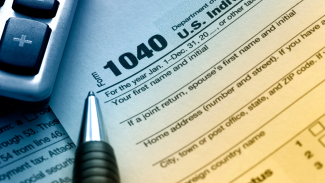
Understanding Marginal and Effective Income Tax Rates
A key factor of the U.S. personal income tax system, which is often misunderstood by taxpayers, is the progressive nature of the personal income tax rate, which means the tax rate increases as the level of income increases.
Two key metrics involved in income tax planning are marginal tax rate and effective tax rate. This article will define each of these rate types and provide examples to help the reader understand how they differ. This will help the reader better assess tax-impacting decisions related to income, investments, retirement savings plans and tax deductions.
U.S. Federal Income Tax Brackets for 2023
|
Marginal Tax Rate |
Single |
Married Filing Jointly |
Head of Household |
|
10% |
$0 to $11,000 |
$0 to $22,000 |
$0 to $15,700 |
|
12% |
>$11,000 to $44,725 |
>$22,000 to $89,450 |
>$15,700 to $59,850 |
|
22% |
>$44,725 to $95,375 |
>$89,450 to $190,750 |
>$59,850 to $95,350 |
|
24% |
>$95,375 to $182,100 |
>$190,750 to $364,200 |
>$95,350 to $182,100 |
|
32% |
>$182,100 to $231,250 |
>$364,200 to $462,500 |
>$182,100 to $231,250 |
|
35% |
>$231,250 to $578,125 |
>$462,500 to $693,750 |
>$231,250 to $578,100 |
|
37% |
>$578,125 |
>$693,750 |
>$578,100 |
|
Source: Internal Revenue Service |
|||
Marginal Tax Rate
The basis of the progressive nature of the U.S. federal income tax structure, a taxpayer’s marginal tax rate is based on their taxable income, which is the net amount of income after adjustments and either the standard deduction or itemized deductions are subtracted from the taxpayer’s adjusted gross income. On the 2022 IRS Form 1040, your taxable income is line 15.
Put differently, the marginal tax rate is the tax rate paid on the next dollar of income earned. Using the table above, the marginal tax rate for a single taxpayer with taxable income of $90,000 is 22%. Their next dollar of income will be taxed at 22%.
Effective Tax Rate
Most references define a taxpayer’s effective tax rate as their total income tax paid divided by their taxable income. Using the 2022 Form 1040 as a guide, this would be line 24 divided by line 15.
You may also find references to the effective tax rate being calculated as the total tax paid (line 24 on 2022 Form 1040) divided by the total income (line 9 on 2022 Form 1040). This calculation method eliminates the effect of any income adjustments and deductions from being taken into account.
Marginal vs. Effective Tax Rate Example
An example will help show the difference between marginal and effective tax rates. Our example below is a single taxpayer with $90,000 in taxable income.
|
2023 Tax Rate Tier |
Marginal Tax Rate |
Income Subject to this Tax Rate |
Tax Paid at this Rate |
|
$0 - $11,000 |
10% |
$11,000 |
$1,100 |
|
$11,001 - $44,725 |
12% |
$33,725 |
$4,047 |
|
$44,726 - $95,375 |
22% |
$45,275 |
$9,961 |
|
$95,376 - $182,100 |
24% |
$0 |
$0 |
|
TOTAL TAX PAID |
$15,108 |
||
This person’s marginal tax rate is 22% (the tax rate on the next dollar of income earned), and their effective tax rate is 16.8% ($15,108 divided by $90,000). A taxpayer’s effective tax rate will typically be less than their marginal tax rate.
Important note: I have had clients balk at receiving additional income in a given year (such as a raise), and claim, “that will put me in a higher tax bracket”, implying that all of their taxable income will thus be taxed at the higher marginal tax rate. This reasoning is INCORRECT: a portion of the additional income MAY be taxed at a higher marginal tax rate if the income bumps the taxpayer into the next-higher bracket, but only a portion of the additional income will be taxed at that marginal rate. Using the taxpayer cited above with taxable income of $90,000: if this taxpayer earns an additional $8,000 of taxable income for a total of $98,000 in taxable income, $5,375 of the additional income is taxed at 22%, and $2,625 of the additional income is taxed at 24%. Even though this taxpayer is now in the 24% tax bracket, only $2,625 of her income is taxed at the 24% rate.
Using the same example structure as above, now with $98,000 in taxable income:
|
2023 Tax Rate Tier |
Marginal Tax Rate |
Income Subject to this Tax Rate |
Tax Paid at this Rate |
|
$0 - $11,000 |
10% |
$11,000 |
$1,100 |
|
$11,001 - $44,725 |
12% |
$33,725 |
$4,047 |
|
$44,726 - $95,375 |
22% |
$50,650 |
$11,143 |
|
$95,376 - $182,100 |
24% |
$2,625 |
$630 |
|
TOTAL TAX PAID |
$16,920 |
||
This person’s marginal tax rate is now 24%, and their effective tax rate is 17.3% ($16,920 divided by $98,000).
Bottom Line
Understanding the difference between your marginal tax rate and your effective tax rate is important for tax planning, particularly when considering topics such as selecting traditional vs. Roth retirement plan types, the potential benefits of Roth conversions, deferring compensation into a future period and the impact of various tax deductions and adjustments.
You may find it helpful to talk to a tax professional or financial advisor about questions or concerns you have regarding your income taxes and tax planning topics.
*This content was developed from sources believed to be providing accurate information. The information provided is not intended as tax or legal advice, and readers are encouraged to seek advice from their own tax or legal counsel. Neither the information presented, nor any opinion expressed, constitutes a representation by us of a specific investment or the purchase or sale of any securities. Asset allocation and diversification do not ensure a profit or protect against loss in declining markets. This material was developed and produced by Eustace Advisors to provide information on a topic that may be of interest. Copyright 2023 Eustace Advisors.
Resources

